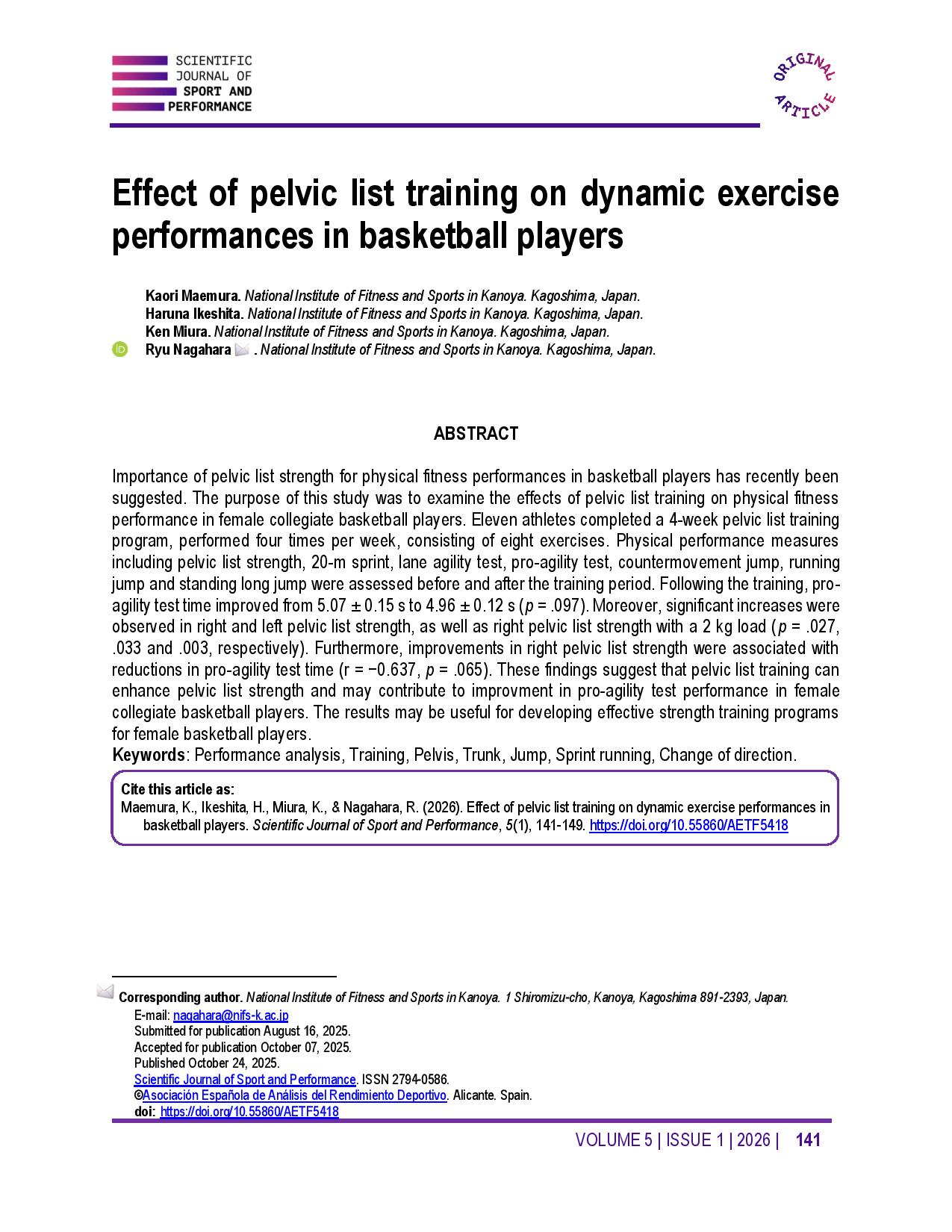Effect of pelvic list training on dynamic exercise performances in basketball players
Main Article Content
Abstract
Importance of pelvic list strength for physical fitness performances in basketball players has recently been suggested. The purpose of this study was to examine the effects of pelvic list training on physical fitness performance in female collegiate basketball players. Eleven athletes completed a 4-week pelvic list training program, performed four times per week, consisting of eight exercises. Physical performance measures including pelvic list strength, 20-m sprint, lane agility test, pro-agility test, countermovement jump, running jump and standing long jump were assessed before and after the training period. Following the training, pro-agility test time improved from 5.07 ± 0.15 s to 4.96 ± 0.12 s (p = .097). Moreover, significant increases were observed in right and left pelvic list strength, as well as right pelvic list strength with a 2 kg load (p = .027, .033 and .003, respectively). Furthermore, improvements in right pelvic list strength were associated with reductions in pro-agility test time (r = −0.637, p = .065). These findings suggest that pelvic list training can enhance pelvic list strength and may contribute to improvment in pro-agility test performance in female collegiate basketball players. The results may be useful for developing effective strength training programs for female basketball players.
Article Details

This work is licensed under a Creative Commons Attribution-NonCommercial-ShareAlike 4.0 International License.
References
Bissas, A. I., & Havenetidis, K. (2008). The use of various strength-power tests as predictors of sprint running performance. Journal of Sports Medicine and Physical Finess, 48(1), 49-54.
Drinkwater, E. J., Pyne, D. B., & McKenna, M. J. (2008). Design and interpretation of anthropometric and fitness testing of basketball players. Sports Medicine, 38(7), 565-578. https://doi.org/10.2165/00007256-200838070-00004 DOI: https://doi.org/10.2165/00007256-200838070-00004
Feng, W., Wang, F., Han, Y., & Li, G. (2024). The effect of 12-week core strength training on dynamic balance, agility, and dribbling skill in adolescent basketball players. Heliyon, 10(6), e27544. https://doi.org/10.1016/j.heliyon.2024.e27544 DOI: https://doi.org/10.1016/j.heliyon.2024.e27544
Jones, B., & Kenward, M. G. (2003). Design and analysis of cross-over trial. In (2nd. ed., pp. 407). CRC Press. https://doi.org/10.1201/9781420036091 DOI: https://doi.org/10.1201/9781420036091
Luo, S., Soh, K. G., Zhao, Y., Soh, K. L., Sun, H., Nasiruddin, N. J. M., Zhai, X., & Ma, L. (2023). Effect of core training on athletic and skill performance of basketball players: A systematic review. PloS One, 18(6), e0287379. https://doi.org/10.1371/journal.pone.0287379 DOI: https://doi.org/10.1371/journal.pone.0287379
Maemura, K., Ikeshita, H., Miura, K., & Nagahara, R. (2025). Pelvic list strength could be important for speed, jump and agility in basketball. International Journal of Sports Science & Coaching. https://doi.org/10.1177/17479541251361223 DOI: https://doi.org/10.1177/17479541251361223
Mancha-Triguero, D., Garcia-Rubio, J., Calleja-Gonzalez, J., & Ibanez, S. J. (2019). Physical fitness in basketball players: a systematic review. Journal of Sports Medicine and Physical Finess, 59(9), 1513-1525. https://doi.org/10.23736/S0022-4707.19.09180-1 DOI: https://doi.org/10.23736/S0022-4707.19.09180-1
Marshall, B. M., Franklyn-Miller, A. D., King, E. A., Moran, K. A., Strike, S. C., & Falvey É, C. (2014). Biomechanical factors associated with time to complete a change of direction cutting maneuver. Journal of Strength and Conditioning Research, 28(10), 2845-2851. https://doi.org/10.1519/JSC.0000000000000463 DOI: https://doi.org/10.1519/JSC.0000000000000463
Mills, J. D., Taunton, J. E., & Mills, W. A. (2005). The effect of a 10-week training regimen on lumbo-pelvic stability and athletic performance in female athletes: A randomized-controlled trial. Physical Therapy in Sport, 6(2), 60-66. https://doi.org/10.1016/j.ptsp.2005.02.006 DOI: https://doi.org/10.1016/j.ptsp.2005.02.006
Nagahara, R., Matsubayashi, T., Matsuo, A., & Zushi, K. (2018). Kinematics of the thorax and pelvis during accelerated sprinting. Journal of Sports Medicine and Physical Finess, 58(9), 1253-1263. https://doi.org/10.23736/S0022-4707.17.07137-7 DOI: https://doi.org/10.23736/S0022-4707.17.07137-7
Nagahara, R., & Murata, M. (2024). Support leg joint kinetic determinants of maximal speed sprint performance. Journal of Sports Sciences, 42(24), 2506-2516. https://doi.org/10.1080/02640414.2024.2445430 DOI: https://doi.org/10.1080/02640414.2024.2445430
Nagahara, R., Yoshizuka, K., & Yoneta, K. (2025). Pelvic list strength test as an indicator of sprint running performance. Journal of Sports Medicine and Physical Finess, 65(6), 749-755. https://doi.org/10.23736/S0022-4707.25.16457-8 DOI: https://doi.org/10.23736/S0022-4707.25.16457-8
Ning, C. (2022). Scientific Training of Athletes' Core Strength in Competitive Sports. Revista Brasileira de Medicina do Esporte, 28(3), 238-241. https://doi.org/10.1590/1517-8692202228032021_0490 DOI: https://doi.org/10.1590/1517-8692202228032021_0490
Pandy, M. G., Lai, A. K. M., Schache, A. G., & Lin, Y. C. (2021). How muscles maximize performance in accelerated sprinting. Scandinavian Journal of Medicine and Science in Sports, 31(10), 1882-1896. https://doi.org/10.1111/sms.14021 DOI: https://doi.org/10.1111/sms.14021
Ramos, S., Volossovitch, A., Ferreira, A. P., Barrigas, C., Fragoso, I., & Massuça, L. (2020). Differences in Maturity, Morphological, and Fitness Attributes Between the Better- and Lower-Ranked Male and Female U-14 Portuguese Elite Regional Basketball Teams. Journal of Strength and Conditioning Research, 34(3), 878-887. https://doi.org/10.1519/JSC.0000000000002691 DOI: https://doi.org/10.1519/JSC.0000000000002691
Sado, N., Yoshioka, S., & Fukashiro, S. (2019). The sidestep cutting manoeuvre requires exertion of lumbosacral lateral flexion torque to avoid excessive pelvic obliquity. Sports Biomechanics, 18(2), 135-145. https://doi.org/10.1080/14763141.2019.1572780 DOI: https://doi.org/10.1080/14763141.2019.1572780
Sado, N., Yoshioka, S., & Fukashiro, S. (2023). Pelvic elevation induces vertical kinetic energy without losing horizontal energy during running single-leg jump for distance. Eur J Sport Sci, 23(7), 1146-1154. https://doi.org/10.1080/17461391.2022.2070779 DOI: https://doi.org/10.1080/17461391.2022.2070779
Şahiner, V., & Koca, F. (2021). Investigation of the Effect of 8 Weeks Core Training Program on Free Shooting and Vertical Jump Performance in Basketball Players Aged 16-18. European Journal of Physical Education and Sport Science, 7(2). https://doi.org/10.46827/ejpe.v7i2.3882 DOI: https://doi.org/10.46827/ejpe.v7i2.3882
Stojanović, E., Aksović, N., Stojiljković, N., Stanković, R., Scanlan, A. T., & Milanović, Z. (2019). Reliability, Usefulness, and Factorial Validity of Change-of-direction Speed Tests in Adolescent Basketball Players. Journal of Strength and Conditioning Research, 33(11), 3162-3173. https://doi.org/10.1519/JSC.0000000000002666 DOI: https://doi.org/10.1519/JSC.0000000000002666
Tazji, M. K., Sadeghi, H., Abbasi, A., Aziminia, M., Shahhosseini, A., Marjani, M. E., & Koumantakis, G. A. (2023). The Effects of Core Stabilization Trunk Muscle Fatigue on Lower Limb Stiffness of Basketball Players. Sports (Basel), 11(10). https://doi.org/10.3390/sports11100200 DOI: https://doi.org/10.3390/sports11100200




